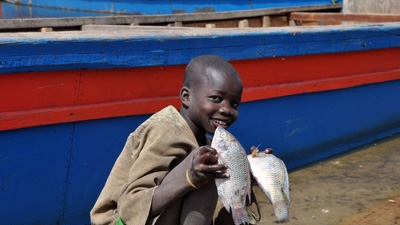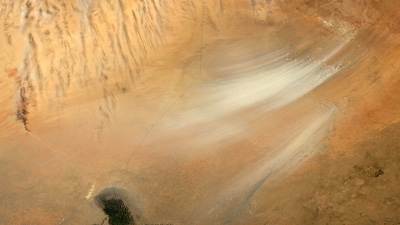Q. Satellite photos show us that Lake Chad has dramatically declined in size from what it used to be in the 1960s, yet the basin area supports a population of some 30 million people. Can you tell us what you found when you visited Lake Chad and the surrounding region?
A. My initial impressions about Lake Chad were confirmed during our visit. The desert is encroaching on what once was one of the largest water bodies in Africa. As you probably know, the latest information tells us that the lake’s water level and size has shrunk a massive 90% compared with that it was in the 1960s, while its surface area has decreased from a peak of 25,000 square kilometers to approximately 1,350 sq.km today.
Climate changes, which have resulted in more droughts and less rainfall, have helped to create conditions leading to the Lake’s general decline.
Yet Lake Chad is still at the center of life in a huge expanse of arid Sahelian Africa. The people living in the Lake Chad basin are having to deal with the consequences of the shrinking of the lake and its associated aquifers, such as a clear decline in the perennial vegetation that previously sprouted each year. Population growth, so prevalent throughout Africa, means more people are dependent on the disappearing water and forest resources.
Q: You’ve said that the issues surrounding Lake Chad are multidimensional, and any steps taken towards resolving them will require different stakeholders to work together to come up with effective solutions. What are the challenges facing such trans-boundary cooperation, and what might be the benefits for the riparian countries surrounding Lake Chad?
A: Many of the world’s largest trans-boundary water systems, such as Lake Chad, are managed in a national and fragmented way that is jeopardizing the food supply and livelihoods of billions of people. Running along the borders of five countries and through varying cultures and ethnic loyalties, the diminishing resources of the Lake Chad water basin have led to humanitarian crises and social conflicts in the region. While conflict over waters shared by several countries is common, these waters can also provide a platform for building relationships within countries and across borders that can lead to cooperation and understanding.
We know that joint development of a shared water resource increases the sustainability of the entire water basin. In fact, the World Bank has a lot of experience in dealing with trans-boundary water resources management issues in Africa and elsewhere around the world. Successful projects include activity in the Niger River Basin, the Senegal River Basin, the Nile Basin, and more recently, the Zambezi River in the Africa region. The World Bank has also tackled the issue of declining lake levels in the Aral Sea in Central Asia (Kazakhstan), where Bank support helped reverse deterioration of the Aral Sea, and restore water levels to sustainable levels. This kind of experience could prove useful for Lake Chad.
We also know that the issues surrounding cooperative water management are complex. This holds true for Lake Chad, where the issues are challenging at the sectorial, national and regional levels. As such, they require a variety of stakeholders to cooperate on solutions. The ministers of water, environment and agriculture will have to work together to ensure coordination of policies that affect the lake resources. National institutions can also cooperate with the Lake Chad Basin Commission (LCBC), the regional organization, comprised of Cameroon, Chad, the Central African Republic, Niger, and Nigeria, and responsible for coordinating the management and development of the Lake’s water resources.
Q: After visiting the basin and with the Government of Chad and the LCBC, what do you think the World Bank can do to support the Government in its efforts to save Lake Chad?
A: Our mission sought to better understand the priorities of both the Government of Chad and the regional LCBC concerning the decline in the Lake’s size. We wanted to see if we could know how we can support a blended project using Global Environment Facility (GEF) and LCBC resources that could address ecosystems management, community based, small-scale climate change adaptation, and promote sound and resilient underground water resource management in the agricultural and pastoral sectors.
We met with Government officials in Chad’s relevant ministries, including Environment, Rural and Urban Water Resources, Rural Development, and Pastoralism. We also talked about Lake concerns with the LCBC. And, I’m delighted to report that most authorities we spoke with were appreciative of the Bank’s willingness to engage the Government on this very important issue.
We at the World Bank believe that supporting the cooperative management of trans-boundary waterways is a key to contributing to poverty alleviation and securing peace throughout regions. I’m pleased that we have begun this important discussion with the Chad Government and the LCBC, marking a first step towards restoring the bountiful resources that once surrounded one of the largest waterways in Africa.


